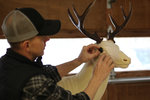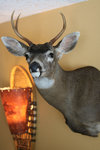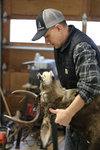


Nestled within the pines by Battle Ground Lake lies Wade Nutter’s taxidermy workshop. It’s filled with easels, sawdust and refrigerated pelts of deer and elk that will soon be stretched and sewn onto antlered forms so hunters can have a visual reminder of their conquests.
Nutter began his business, Nutter’s Taxidermy, in 2008 after a spine injury veered him off his original path as a welder.
“I went to Clark College to be an office clerk but realized that wasn’t going to work because I can’t sit and look at a computer screen for hours on end,” said Nutter, reminiscing on how he came to be a taxidermist. His epiphany led him to metal-work where he spent the majority of his life at shipyards and various fabrication shops. It was a slipped disc in 2006 that halted his career and made him choose another way to make a living.
“I just remember when I would get a deer during hunting season and take it to a taxidermist how fascinated I was with the process of taxidermy,” he remembered, flipping through a photo album filled with fond memories of his hunting exploits.
It wasn’t until his friend Jackie lent some much-needed encouragement that he decided to make the trip up to Kent and attend taxidermy school, focusing primarily on game heads. When he finally obtained his license, he continued to enrich his learnings with more hands-on guidance by pairing up with fellow taxidermist and old Battle Ground High School teacher, Tom Graves. Their relationship was mutually beneficial. Graves was able to knock out some work that had piled up, and Nutter was able to gain a deeper understanding of the practice through multiple problem-solving scenarios.
Their partnership lasted a year and a half before Nutter decided he had enough skills to continue on his own.
The art of taxidermy
The first part to any project are the materials, which in this case is a fresh hide with the face still intact. Nutter then carefully takes the hide off the skull and turns the ears, eyes, lips, and nose inside out, preserving those delicate areas with salt before further preserving the whole hide in a process called “pickling.” Pickling is when the hide is soaked in an acid bath containing chemicals, salt, and water, killing off bacteria and preventing the hair from falling off the skin. The hide is then removed from the bath, but before it has the opportunity to dry and shrink up, Nutter uses a device called a fleshing wheel, which thins out the hide just enough to where the pelt will retain its natural shape and allow for accurate measurements when Nutter goes to order a premade form.
Ordering the form isn’t as easy as shopping for shoes online, though.
Nutter says that hunters typically want their game heads in the position they were last seen through the scope, so before simply ordering the form, factors such as the neck position being turned left or right, the head held up high or down low, and the position of the ears are all things to consider.
“If you watch a deer, they’re fascinating because their ears are always moving. If they hear a car go by and it’s behind them their ears will go back; if they’re angry their ears will go back, and so it’s just what expression you want to have on your deer,” Nutter explained.
After he’s received the form, he mounts the antlers and prepares to sculpt the eyes.
It’s a step that requires the whole day as he takes pre-made eyeballs, fills them with clay, and shapes it onto the form to achieve the desired expression.
The aforementioned ears are next. As he leaves the wide-eyed form to dry, he pulls out the pickled pelt and begins to shape the ears. This requires him to cut out the cartilage left behind and replace it with more synthetic support: just a little bit of glue and a shelled ear form that comes separated from the head form.
Once the ears are completed, Nutter slips the hide over the antlered form, filling out the deflated head. It almost resembles the real thing at this point, but there are still a few steps left before he is ready to have his customer come pick up the piece.
The skin around the eyes, nose, and antlers get tucked in, the hide gets pulled back, pinned, glued and sewn into place, and spots on the pelt that may have been damaged in transportation such as drag marks or bullet holes get touched up. When he’s finally 90 percent happy with the product, he hangs it up on the wall and leaves it for the next day where he can approach it with a fresh mind to reshape eyes or ears before the clay and glue completely hardens.
It takes a week or two for the game head to completely dry before he goes back over with an airbrush to color in spots that may have lost some color with the absence of blood, such as the ears or around the eyes. The result is a striking realistic rendition of the animal in all its glory and the perfect trophy for a hunter to look at and remember a successful day in the wilderness.
With completed mounts on display throughout Nutter’s house, oil paintings and metallic landscapes scattered in between, it’s clear he’s enjoying this new walk of life that lets him explore his passions.
{{tncms-inline content="<p class="p1"><span class="s1">When Wade Nutter isn&rsquo;t salting pelts or shaping clay, he&rsquo;s busy carving eagles into logs and recreating photographic landscapes on canvas. You can view his work by contacting him or attending the Clark County Fair in the summer.<span class="Apple-converted-space">&nbsp;</span></span></p>" id="114a8df5-6f7b-416d-80dc-aef038790d33" style-type="bio" title="During the offseason" type="relcontent"}}
{{tncms-inline content="<p class="p1"><span class="s1">Nutter&rsquo;s Taxidermy</span></p> <p class="p1"><span class="s1">Phone: 360-281-4595</span></p>" id="b46befba-bb3c-4030-b771-a6f66dd7c748" style-type="bio" title="Contact information " type="relcontent"}}